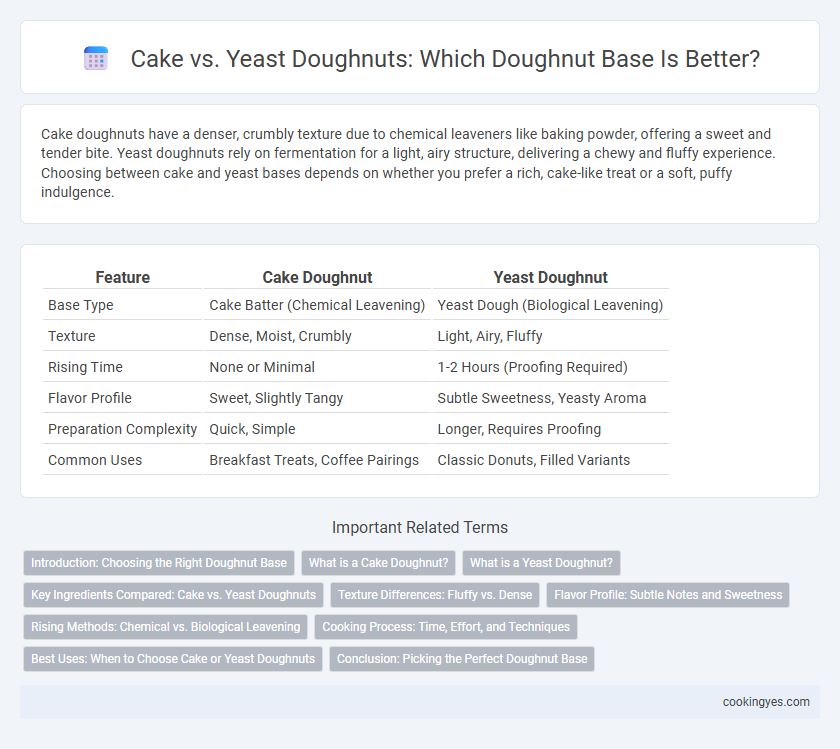Cake doughnuts have a denser, crumbly texture due to chemical leaveners like baking powder, offering a sweet and tender bite. Yeast doughnuts rely on fermentation for a light, airy structure, delivering a chewy and fluffy experience. Choosing between cake and yeast bases depends on whether you prefer a rich, cake-like treat or a soft, puffy indulgence.
Table of Comparison
| Feature | Cake Doughnut | Yeast Doughnut |
|---|---|---|
| Base Type | Cake Batter (Chemical Leavening) | Yeast Dough (Biological Leavening) |
| Texture | Dense, Moist, Crumbly | Light, Airy, Fluffy |
| Rising Time | None or Minimal | 1-2 Hours (Proofing Required) |
| Flavor Profile | Sweet, Slightly Tangy | Subtle Sweetness, Yeasty Aroma |
| Preparation Complexity | Quick, Simple | Longer, Requires Proofing |
| Common Uses | Breakfast Treats, Coffee Pairings | Classic Donuts, Filled Variants |
Introduction: Choosing the Right Doughnut Base
Cake doughnuts rely on chemical leaveners like baking powder or baking soda, producing a dense and tender texture ideal for rich flavors. Yeast doughnuts use fermentation to create a light, airy crumb with a slight chewiness, enhancing a fluffy mouthfeel. Selecting the right base depends on desired texture and flavor intensity, with cake doughnuts favoring robustness and yeast doughnuts emphasizing lightness.
What is a Cake Doughnut?
A cake doughnut is made from a dense, cakey batter leavened with baking powder or baking soda, creating a tender crumb distinct from yeast doughnuts. Unlike yeast doughnuts, which rely on yeast fermentation for rise and airy texture, cake doughnuts have a firm, slightly crumbly texture similar to cake. This type of doughnut often has a rich flavor profile and can hold up well to various glazes and toppings without becoming soggy.
What is a Yeast Doughnut?
A yeast doughnut is a type of fried dough that relies on yeast fermentation for leavening, resulting in a light, airy, and fluffy texture. Unlike cake doughnuts that use chemical leaveners like baking powder or baking soda, yeast doughnuts undergo a rising process that develops a more complex flavor and a soft crumb. This yeast fermentation process creates larger air pockets, making yeast doughnuts tender and ideal for glazing or filling.
Key Ingredients Compared: Cake vs. Yeast Doughnuts
Cake doughnuts rely on chemical leaveners like baking powder or baking soda, creating a denser and crumbly texture, while yeast doughnuts use live yeast, resulting in a lighter, airy crumb. The flour in cake doughnuts is often blended with sugar and fats for a tender bite, contrasting with the higher gluten development in yeast doughnuts that provides elasticity. Moisture content and resting time differ significantly, with yeast dough requiring fermentation time to develop flavor and volume.
Texture Differences: Fluffy vs. Dense
Cake doughnuts have a dense, crumbly texture due to the use of chemical leaveners like baking powder, giving them a rich, cake-like bite. Yeast doughnuts develop a light, airy, and fluffy texture because the yeast fermentation creates gas bubbles, resulting in a soft and springy crumb. The choice between cake and yeast dough affects the doughnut's mouthfeel, with cake doughnuts offering a firm chew and yeast doughnuts providing a tender, airy lift.
Flavor Profile: Subtle Notes and Sweetness
Cake doughnuts offer a denser texture with a subtly sweet and buttery flavor enriched by vanilla and nutty undertones, creating a rich, satisfying taste. Yeast doughnuts present a lighter, airy crumb with mild sweetness, emphasizing delicate yeast-fermented notes that add complexity and a slight tang. The choice between cake and yeast doughnut bases significantly influences the flavor profile, balancing sweetness with either a robust, cake-like richness or a tender, nuanced yeast aroma.
Rising Methods: Chemical vs. Biological Leavening
Cake doughnuts use chemical leavening agents like baking powder or baking soda, which produce carbon dioxide quickly when exposed to heat, resulting in a dense and tender texture. Yeast doughnuts rely on biological leavening, where yeast ferments sugars to release carbon dioxide gradually, creating a lighter and airier crumb with a slightly tangy flavor. The rising method significantly impacts the doughnut's texture and taste, with chemical leavening offering speed and consistency, while biological leavening provides depth and complexity through fermentation.
Cooking Process: Time, Effort, and Techniques
Cake doughnuts require a quicker cooking process, typically frying at 350degF for about 2-3 minutes per side, using a batter mixed with baking powder for leavening. Yeast doughnuts involve a longer preparation, with dough rising times of 1-2 hours before frying at similar temperatures for 1-2 minutes per side, demanding more skill in proofing and handling delicate, elastic dough. The cake method offers a simpler, faster technique while yeast doughnuts yield a lighter texture through fermentation and careful dough conditioning.
Best Uses: When to Choose Cake or Yeast Doughnuts
Cake doughnuts offer a dense, tender texture ideal for flavors that incorporate spices or fruit, making them perfect for quick baking or when a sturdy base is needed for toppings and glazes. Yeast doughnuts provide a light, airy crumb and slightly chewy texture, suited for yeasty, fermented flavors or when a fluffy, pillow-like bite is desired, especially for filled or glazed variations. Choose cake doughnuts for fast preparation and rich texture, while yeast doughnuts excel in achieving a soft, delicate rise with complex flavor development.
Conclusion: Picking the Perfect Doughnut Base
Choosing between cake and yeast doughnut bases depends on desired texture and flavor profile; cake doughnuts offer a dense, tender crumb with a rich, buttery taste, while yeast doughnuts provide a light, airy texture with subtle fermentation notes. Cake doughnuts are ideal for holding glazes and fillings due to their firmness, whereas yeast doughnuts excel in delivering a soft, fluffy bite that pairs well with a variety of toppings. Ultimately, selecting the perfect doughnut base balances preference for density versus lightness, sweetness versus complexity, and intended topping or filling compatibility.
Cake vs Yeast for doughnut base Infographic

 cookingyes.com
cookingyes.com